Blackpool
Blackpool first appears in FTHM Edition 84
Blackpool is an interesting town in the north west of England and is a coastal resort that has been visited by millions of people. It is located 40 miles northwest of Manchester and 27 miles north of Liverpool whilst Preston is only 15 miles away. According to the 2011 Census, the town’s estimated population was 139,720 which makes it the most populated urban area in the North West of England.
The recent history of Blackpool is fascinating and reflects the changing face of English society. Blackpool was a coastal hamlet throughout the Middle Ages and remained so until the mid-18th century when people began to travel to the coast during the summer months in an attempt to improve their well-being. In 1781, it became easier to access the 7-mile sandy beach thanks to the construction of a new road by Thomas Clifton and Sir Henry Houghton, and significantly, in the same year stagecoaches began running between Blackpool and Manchester (and in 1782, from Halifax) which greatly augmented the number of visitors to the town.
New buildings were erected in the early 19th century by Henry Banks and John Cocker which allowed the population to increase from 500 in 1801, to over 2,500 in 1851. Railways also played a major role in increasing visitor numbers to Blackpool and in the 1840s, the linking by rail to other industrialised parts of Northern England, meant it became a focal point for tourism in the UK – it also resulted in an influx of settlers to the area, and, in 1881, it had a population of 14,000 people.
But now let’s take a look at Blackpool’s more distant past. In 1970, a 13,500-year-old elk skeleton was discovered with man-made barbed bone points on Blackpool Old Road which suggests humans lived in the area as far back as the Palaeolithic era. In addition, it is known that the Fylde (a coastal plain on top of a peninsula) was also where a British sub-tribe of the Brigantes called the Setantii lived from AD80 and who were controlled by the Romans from their fort at Dowbridge.
The Domesday Book in 1086 recorded some of the earliest villages in Fylde which later became part of Blackpool town. Interestingly, it seems that Vikings and Anglo-Saxons lived together peacefully in the area and place names were even joined together e.g. Layton-with-Warbeck. During Medieval times, the area emerged as “Black Poole” and was composed of a few farmsteads. But by the end of the 17th century, Edward Tyldesley had built the first substantial house in the area.
The increased popularity of curing diseases through sea bathing meant that many people came to Blackpool in the 18th century and this was augmented by the building of 4 hotels, an archery stall and bowling greens being established. It is definitely worth pointing out that the closure of Lancashire Cotton factories for a week to service and repair machinery, meant that there was a steady flow of visitors during a prolonged summer season to Blackpool – this was known as ‘Wakes Week’ and was staggered throughout the summer.
The expansion of the town of Blackpool beyond what is now known as ‘the Golden Mile’ in 1893, resulted in the town being the only one with 3 piers as well as a promenade, fortune-tellers, public houses, trams, donkey rides, fish and chip shops and theatres. From the 1880s until the First World War, the town was a magnet for many visitors including the employees of Bass’ Burton brewery who organised annual trips to the seaside. By the 1890s, the population was 35,000 and the town could accommodate 250,000 holidaymakers – it is estimated that 3 million annual visitors spent a week at the resort during this period.
As mentioned, Blackpool was at the cutting edge of modernisation as it was the first municipality in the world to have electric street lighting and to have one of the first electric tramways which was laid from Cocker Street to Dean Street – 1n 1895, a line was added to Fleetwood and, in 1899, overhead wires replaced the conduit system which is still in use today. Other significant occurrences in the town’s history were the construction of Blackpool Tower and the Grand Theatre in 1894. Blackpool’s Illuminations were introduced in 1912 and are still a draw for many people with them being switched on by notables or celebrities.
In the early part of the 20th century, about 8 million people visited the town and mainly came from mill towns in East Lancashire and from the West Riding of Yorkshire. Blackpool was not heavily damaged during the Second World War, and it is thought that this is because Hitler planned to use it as a place of leisure after what he thought would be a successful military campaign. Interestingly, the Free Polish Air Force made its headquarters in exile at Blackpool after the war.
Following the conclusion of the Second World War, Blackpool’s fortunes continued to prosper attracting about 17 million people per year, but then, the decline of the textile industry and people starting to holiday abroad meant that it became more of a day trip location – especially after the building of the M55 motorway in 1975. However, the economy of the town is still very much reliant on tourism.
Today, a visitor to Blackpool can enjoy the tower, the illuminations, the Pleasure Beach, Blackpool Zoo and much more. It certainly still has much to offer the day tripper and those who choose to still holiday there. Indeed, although the town heavily depends on tourism to boost its economy, there are still a large number of small businesses and self-employed people as well as some large employers like National Savings and Investments (based at Marton) and Tangerine Confectionery. If you like a spot of retail therapy, the main shopping streets include Church Street, Bank Hey Street and Market Street – where one can pass a happy hour or so!
Traditionally, many conferences have been held in the town such as major political and trade union conferences, but unfortunately, these have moved to major cities with modern conference centres although happily, the Young Farmers Convention has been held in Blackpool since the late 1960s.
If you want to be entertained at a seaside resort, Blackpool is the perfect place to visit as even though it remains a summer entertainment venue, many local establishments trade all year round. It is primarily known as a venue for variety shows featuring people like Ken Dodd and Ray ‘Chubby’ Brown but people like Britney Spears and Pitbull have also appeared in the town.
It is also worth mentioning that Blackpool began to be promoted as a gay tourist destination in the 1990s and that the first Gay Pride was held there in 2006 – there are many LGBT venues in the town like Flamingo and the Flying Handles. But there are also lots of other theatres and venues which offer excellent entertainment like the Winter Gardens, The Imperial Hotel and Viva Cabaret Show-bar and Events Suite.
Sport is very popular in the town with boxing matches at the Tower Circus Arena and the Winter Gardens, three golf clubs in the area and also Rugby Union and League on offer. If you enjoy watching football, you can go and watch Blackpool F.C. or one of the amateur teams like A.F.C. Blackpool or if you appreciate cricket, you could pay a visit to Blackpool Cricket Club – you could even participate in the annually-held Blackpool Marathon if you’re feeling up to it!
So, if you fancy a good day out or even a good holiday then why not consider a trip to Blackpool as it is well-served by road, rail, air (via Liverpool John Lennon Airport) and there is also the excellent Blackpool Tramway which runs from Starr Gate in Blackpool to Fleetwood. What are you waiting for?!
* With a lot of help from Wikipedia
– More from Dean’s Places here




Recent Comments